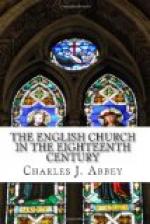The names of many other men, more or less eminent in their day for piety or learning, might be added to the list of those who possessed and valued Robert Nelson’s friendship; among them may be mentioned—Dr. John Mapletoft, with whom he maintained a close correspondence for no less than forty years: a man who had travelled much and learnt many languages, a celebrated physician, and afterwards, when he took orders, an accomplished London preacher; Francis Gastrell, Bishop of Chester, Mapletoft’s son-in-law;[91] Sir Richard Blackmore, another physician of note, and, like Mapletoft, most zealous in all plans for doing good, but whose unlucky taste for writing dull verses brought down upon him the unmerciful castigation of the wits; John Johnson of Cranbrook, with whose writings on the Eucharistic Sacrifice Nelson most warmly sympathised; Edmund Halley, the mathematician, his school playmate and life-long friend; Ralph Thoresby, an antiquarian of high repute, a moderate Dissenter in earlier life, a thoughtful and earnest Churchman in later years, but who throughout life maintained warm and intimate relations with many leading members of either communion; Dr. Charlett, Master of University College, Oxford; Dr. Cave, the well-known writer of early Church History, to whose literary help he was frequently indebted; John Evelyn; Samuel, father of John and Charles Wesley, whose verses, written on the fly-leaf of his copy of the ‘Festivals and Fasts,’ commemorative of his attachment to Nelson and of his reverence for his virtues, used to be prefixed to some editions of his friend’s works; nor should the list be closed without the addition of the name of the eminent Gallican bishop Bossuet, with whom he had become acquainted in France, and had kept up the interesting correspondence already noticed in connection with Bishop Bull.




